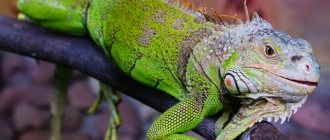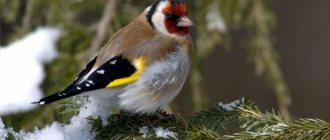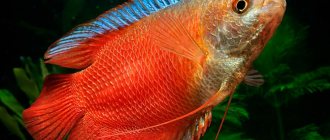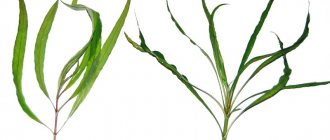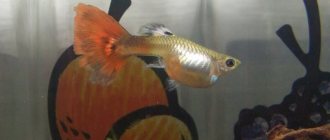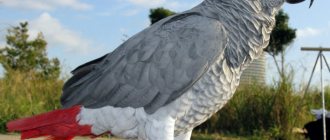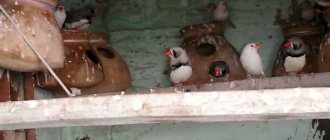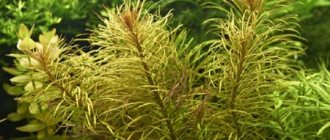Description of birds
Goldfinches belong to the finch family.
The size of the birds is more modest compared to sparrows. The body length of goldfinches is only twelve centimeters. Adults weigh no more than 20 grams. They have a very bright color, but at the same time the surface of the head, tail and wings remain black, making the birds look like real dandies. But on the forehead, tummy and cheeks there are snow-white feathers. You can see a red ring near the beak, and bright yellow stripes on the wings. Outwardly, it is usually very difficult to distinguish a female from a male. In terms of content, there is no difference between them. True, it is believed that their voice data is different.
In nature, goldfinches are quite numerous. They live in Western Siberia, Europe, North Africa and Central Asia. But they prefer to bypass the northern regions. Minor seasonal migrations of birds have led to the emergence of several varieties.
Types of goldfinches
At the beginning of our story, we provide a description of the most common, but far from the only species of goldfinches - the black-headed one. In addition to it, there are several more varieties that differ not only in habitat, but also in external characteristics.
Grey-headed Goldfinch
A slightly larger representative is the gray-headed goldfinch. The length of its body from head to tip of tail can reach as much as seventeen centimeters, in contrast to the twelve centimeter blackhead. This species spreads from northern India to areas of southern Siberia.
The color of his head is devoid of black and white areas, and there is also no manifestation of pure black raven color on his body. The main color of the plumage of the body is cooler grayish; there is still a red edging around the beak.
Linnet is also a specific species of goldfinch. They differ not only in appearance, but also in a clear manifestation of sexual dimorphism. The females do not look so flashy, but the males are truly elegant gentlemen. In spring, their belly is brown with whitish sides. And the chest and main area of the body are distinguished by reddish tints, which females, unfortunately, lack.
These birds live in Eurasian countries, as well as in western North African landscapes. Linnet differs not only in its external characteristics, but also in its vocal preferences. You see, this species of goldfinches prefers to sing in a group. At the same time, the “music” does not sound out of place. Their singing is harmonious and doubly melodic.
The greenfinch has a distinctive green tint to the feathers on its back. The greenish color also extends to the head, wings and tail of the bird. The tail and wings are divided into gray and green areas, the neck is gray. In size, this species is more comparable to a sparrow. Unfortunately, its singing is more like that of a sparrow. When buying this species of goldfinch, you should not count on loud trills; its songs are more like the buzzing of a bee.
The fire siskin is the brightest twelve-gram representative of the species. The main part of its small body is colored fiery red-orange. It is also favorably emphasized by the black and white areas of the plumage.
In the wild, they form small flocks, occupying areas of the tropics, woodlands and tropical gardens. Unfortunately, at the moment they can only be found in rare areas of the wilderness of Venezuela, since these birds were subjected to uncontrolled capture for the beauty of their appearance.
In Venezuela they are protected, but even in this state of affairs, it is difficult to stop poachers, because on the black market the price for fire siskin is very high and the temptation is too great.
Is it worth keeping a goldfinch in your house?
Is it possible to keep goldfinches at home? Of course. But it is worth knowing all the features of these birds. In general, keeping goldfinches has its advantages. The birds have very beautiful plumage, which makes their owners happy. In addition, goldfinches sing beautifully, and you can enjoy their voice almost all year round; only during periods of molting do they become silent.
Goldfinches at home delight owners with their friendly nature. In addition, they are very smart, and therefore learn quickly. Birds willingly become tame. The hybrid of a canary and a goldfinch is distinguished by its external beauty and a very attractive voice. In general, you shouldn’t take wild specimens to keep goldfinches at home, since you probably won’t be able to tame them. You need to purchase pets in specialized places.
Where to keep pets?
It is necessary to keep goldfinches at home in cages or enclosures. Birds quickly settle down and get used to completely new conditions. The main thing is to be able to create the necessary comfort. For a bird cage, it should not be less than 50 centimeters in length. In addition, it must necessarily be two-tiered.
It is very important that the cage has a distance between the bars of no more than 1.5 centimeters, since otherwise the pet may slip out and fly away, and in the worst case, even injure itself.
General cleaning of the bird's cage is carried out every week. To do this, use special non-hazardous detergents. It is imperative to thoroughly wash the perches, feeders, and drinkers. All items are not only washed, but also dried. You should be especially attentive to drinking water and bathing water.
Breeding goldfinches at home is a simple matter. Birds reproduce well throughout the year. The female must be provided with everything she needs to build a nest in which she will later lay eggs. Birds use feathers, lichen, meadow grass, bark, birch bark, moss, animal hair, etc. as building materials.
We suggest you read: Feeding bees in February. How to feed bees in winter and early spring: advice from experienced beekeepers
Females lay no more than six eggs, colored blue. There are purple blotches and stripes on their surface. Responsibility for incubating the offspring falls entirely on the female. She incubates the chicks for several weeks. It is very important to place the male in another cage after fertilization. Otherwise, he may distract the female from her direct responsibilities.
Once born, the chicks develop very quickly. In just two weeks they become completely independent, and therefore can leave their native nest. But still, in order for the babies to get stronger and be fully ready for independent life, they need to be kept next to their mother for about a week.
Sometimes there are cases when females refuse to hatch their own offspring. But it doesn't matter. Eggs can be kept under a lamp, as if in an incubator.
Goldfinches diet
Goldfinches are an important link in the food chain. They are forest health workers because they exterminate pests that parasitize tree trunks and agricultural crops. Leaving their homes, they gather in small groups to search for a source of food.
It is not uncommon to find flocks of goldfinches in rural fields and lands rich in insects or seeds. The bulk of the diet comes from seeds of various plants. Anything is suitable, but the favorites are the seeds of thistle and burdock.
During periods of lack of seed food, they switch to a plant menu consisting of leaves and thin stems. The larvae are used in the process of feeding the young. It is better to use ready-made industrial mixtures as food for home keeping.
Only in this way can you provide your pet with a varied menu, just like in the wild. In this case, crushed crackers, dried or frozen herbs, and the yolk of a boiled egg will be good feeding. Ant larvae and mealworms are needed as delicacy meats.
Some features
According to reviews, goldfinches must be kept separately at home. Keeping birds in the same cage can harm your pets. Oddly enough, females and males strongly conflict with each other when they are in the same space. And this has a bad effect on the well-being of birds. Males, against the backdrop of everyday problems, can become sad and lethargic, and even stop singing. But living in different cages or neighboring enclosures suits the birds quite well.
When talking about how to care for a goldfinch at home, it is worth remembering that from time to time the birds must be allowed out of their enclosures or cages to fly. In addition, it is necessary to change the water for bathing and drinking every day. Fresh fluid is the key to your pet's health.
What to feed the goldfinch at home?
At home, goldfinches should be fed with grain mixtures, which include plantain, sunflower, hemp, millet, dandelion, burdock, and oatmeal. Speaking about what goldfinches eat at home, it is worth remembering the need for mealworms and ant pupae in the diet.
Birds love porridge and all kinds of wet mash. This type of food should be given up to twice a week. Usually goldfinches eat twice a day, and eat a little at a time. What do you think is the bird's favorite treat? These are boiled carrots that need to be grated. You should add a boiled egg and crackers to the delicacy.
Goldfinches also benefit from plant foods, such as plantain and dandelion.
Useful food additives
In order to strengthen the bones of your own pets, especially when the nesting period comes, in order to strengthen the shells of future eggs, you can add the shells of the eggs themselves, rose hips and corn to the food. In this case, you can use a standard coffee grinder for improved shell crushing. Goldfinches should consume the provided vitamin and mineral particles about 2-3 times every seven days.
Sources of fats are hemp, flax, and sunflower seeds. They must be present in the body, but you need to know a certain dosage of this energy source. For birds, obesity poses a considerable danger, as for other living organisms.
Animal food can also be included in the goldfinch’s varied diet. In winter, it is recommended to give the goldfinch about four mealworms per day. In the summer, it is better to find ant pupae in the forest and bring them to the bird. The goldfinch should eat once a day. You should feed him in the morning. It is enough to pour into the feeder the amount of food that is the daily norm. Approximately, this is about 2 teaspoons of grain impurities.
A considerable number of goldfinches refuse animal food items, which are mealworms, fruit flies (fruit flies), and bloodworms. The reason for this may be that all birds, not only the goldfinch, must mainly catch insects (in this case, aphids) in order to fully feed their own chicks.
If, by its nature, the goldfinch feeds independently both in winter and in summer, then the owner must specially prepare food for the bird. The preparations can be dried weed branches with seeds, bunches of berries that were collected during their full ripening, and were found as far as possible from the dust of urban areas and roadways.
We invite you to familiarize yourself with: Varieties of aquatic and land turtles for home keeping
It is possible to purchase a ready-made mixture, which is intended mainly for canaries or siskins. However, it is necessary to supplement the admixture with sunflower. One of the most important factors is the presence of always fresh water. Tap water is not of excellent quality, so freezing it completely is the best option.
When it can thaw, it is necessary to pour out the sediment. Then you need to keep this water at room temperature. Tap water must always be subject to its own sedimentation so that the chlorine elements can erode and rust can settle. It is necessary to fill the drinking bowl about twice a day.
The goldfinch is not a whimsical bird. But this does not mean that you do not need to pay attention to its proper feeding and the required level of health. At best, the goldfinch will always be able to please its owner with its spectacular plumage and luscious singing.
The food of the goldfinch is practically no different from the diet of the above-mentioned canary. Quite a large number of birds love to eat berries, grains and midges. In order to satisfy the goldfinch’s nutrition in your cage, you don’t have to worry too much. One of the most important rules is about variety in food!
Diseases of birds
Diseases that affect canaries and parrots are also dangerous for goldfinches. If you notice that the bird is not drinking or eating, there is discharge near the beak, feathers are falling off, gastrointestinal function is disrupted, the eyes are dull, the pet must be urgently taken to the veterinarian. The doctor will help establish the correct diagnosis and prescribe treatment.
We suggest you read: When should a kitten be vaccinated against distemper? Vaccinating a cat against distemper
In addition, goldfinches are quite capable of having human ailments. The most common option is gout. The first signs of the disease may be thirst and a sharp change in the mood of the feathered pet. If you follow all the rules for keeping a goldfinch, the bird feels very good at home and does not get sick.
Bird walks
We have already mentioned that goldfinches must fly outside the cage. Free flight around the house or apartment is a prerequisite for a healthy lifestyle for a pet. This is due not only to the fact that the bird is bored and needs to spread its wings, but also to its feeding habits. It's no secret that goldfinches get a lot of fat.
This means that they are susceptible to obesity. To avoid such a problem, it is necessary to give the bird more greens, fruits and vegetables. And the goldfinch must fly without fail. Some owners say that they have managed to tame their pets so much that they fly into the cage only to sleep at night.
If you allow your bird to move around the apartment, it will probably choose places such as closets, high cabinets and other high places. This can be explained quite simply, because in the wild, goldfinches prefer to be in tall trees. An interesting fact is that goldfinches, no less than parrots, adore mirrors.
A treat for the goldfinch
Goldfinches trust people, just like budgerigars. By nature, they have considerable mobility and dexterity in obtaining seeds of various plants. They usually jump in trees, and sometimes hang on thin branches in order to peck, for example, birch seed from catkins.
They love burdock seeds. If the goldfinch is in a cage, then it should receive them in the form of ready-made food. Although you can find burdock heads by inviting the goldfinches to tinker with them. However, there will be thorns scattered everywhere. Therefore, it is better to present the seeds open.
There is no shortage of ready-made food for goldfinches. You can also buy a special mixture of grains for them. This “mix” should include the following elements: seeds, dandelion and salad with millet, wormwood with rapeseed.
In addition to seeds, the diet may also include various grasses. You can also feed carrots, which are mixed with grated eggs and wheat breadcrumbs. Greens can be frozen and dried. But it should not be exposed to open sunlight. It should be stored in cardboard and fabric boxes and bags, and in glass jars. Do not forget the fact that drinking water must be clean and well-settled.
We invite you to familiarize yourself with: American Toy Fox Terrier dog with description and photo, prices for puppies in kennels
Is it possible to tame a goldfinch?
Goldfinches are distinguished by their intelligence and intelligence. They can easily be taught to fly to your hand for food. Very often, goldfinches are taught all sorts of tricks. For example, pulling out fortune cards for people.
However, it is worth remembering that wild individuals differ in behavior from acquired ones. Once in a cage from the outside, pets often run wild. Speaking about how to tame a goldfinch at home, we can confidently say that in just three months you can turn a wild bird into a tame one. True, you will have to show maximum patience and desire.
During the first week, the bird must be kept completely alone. Next, the cage is moved to a crowded place in the apartment, covered with a rag. Gradually the curtain opens, showing the pet the world around it. During the third week, the goldfinch eats in the presence of its owner, who is only a few meters from the cage.
Gradually, after a month, most of the goldfinches begin to try to sing. In the future, you can get closer and closer to the bird during its meal. You can try placing one seed on a perch and wait for the goldfinch to grab it. Then you can put the next one. This way the bird gradually gets used to your presence.
We suggest you familiarize yourself with: Cat breeds by shedding level. Cat breeds that do not shed, light shed, moderate shed, and heavily shed.
Habits of goldfinches
Having acquired a pet, you will certainly have to teach it to fly around the apartment or room. Before each walk, you need to make sure that the windows and doors are closed so that the bird does not fly away from you. The cage must initially be installed in a permanent location. Then every day you can open the door and invite your pet to fly out to you.
When starting training, you can attract the bird’s attention with something tasty or a bouquet of greens, to which the goldfinch will certainly respond. The feathered friend must gradually adapt and leave the cage without any fear. When flying out into the wild, the bird will probably decide to sit on your head or shoulder. This is a completely normal desire.
No matter how much you love your feathered companion and no matter how tame he is, it's always a good idea to follow safety rules. Open windows are a taboo. You never know what comes into a bird's head. It may even inadvertently fly out of an open window. But the birds cannot find the way back. The glass itself can also pose a danger - if a goldfinch crashes into it while accelerating, it can be injured.
In general, if a pet is on a walk and flies around the apartment, then the owners should be very careful not to inadvertently crush it under the door, sit on it, or step on it. In addition, it is very dangerous to overfeed a bird. Obesity can greatly undermine a pet's health.
Description of goldfinches
Externally, the goldfinch bird resembles a bright, animated flower. In addition to its bright coloring, the bird has a wonderful voice, thanks to which it is often kept in captivity. These are not picky pets. The goldfinch is no larger in size than an ordinary sparrow, however, size does not affect the impression of the bird.
Its wonderful singing is comparable to that of a nightingale or a canary, and with proper care of the animal, its rich trills can be enjoyed all year round. As a rule, the goldfinch becomes quiet only for a short period of molting.
Appearance
The body size of an adult goldfinch does not exceed twelve centimeters. This is a twenty-gram singer with a wonderful voice and extreme activity. The small head of the animal is decorated with a peculiar small cap of bright red color.
The eyes are black and small, like beads. On the back of the bird's head there is a blackish cross of feathers, which harmonizes well with the brown spots of the chest. The multi-colored beak of the goldfinch is topped on the sides with white cheeks that stand out against the general background. The goldfinch's belly is also white.
View this post on Instagram
Posted by Natalia Bebko (@natabebko) Feb 11, 2021 at 1:10 PST
There is a red rim around the beak. But it cannot be found in young animals. The little chicks differ from the sparrow only in the bright yellow feathers on their wings. The body is supported by light pinkish-brownish paws. This is a description of the most common species of goldfinches - the black-headed one. It is not difficult to understand where the species got its name.
An adult goldfinch is a rare work of nature, a bright miracle, looking at which the eye and soul rejoice. The tail of the animal is black, not too long. The rest of the plumage is variegated in different colors, among which reddish-yellowish-beige shades predominate. The wings are black, like the tail, with only white markings on the upper part, as well as a yellow stripe crossing the wing in the middle.
Character and lifestyle
Goldfinches are extremely active birds; you won’t find them sitting on the ground or on a branch. The goldfinch leads an active lifestyle, but even in the sky, thanks to its bright, unique coloring, it is difficult to confuse it with any other bird. They spend most of their lives in the air.
Particular attention should be paid to the singing of this bird. More than twenty melodies are present in her repertoire. The singing of the goldfinch sounds differently. The palette ranges from heartbreaking grinding to melodic canary overflows.
Goldfinches do not tolerate low temperatures. At the same time, they do not migrate to warm countries, but simply gather in pairs or small groups to make it easier to endure the cold period.
These birds often end up in the snares of bird catchers, after which they are sold on markets and store shelves for home keeping in captivity. The common goldfinch is an excellent choice as a pet. Its bright plumage pleases the eye, and its unsurpassed singing pleases the ear. A bird caught in captivity does not begin to sing from the first day.
It will take a couple of months and careful maintenance for your goldfinch to start singing. At first, hesitant crackles will begin to jump out of his mouth, but over time his voice will become more confident, and the trills will become louder, longer and more fluent.
View this post on Instagram
Posted by Natalia Bebko (@natabebko) Feb 6, 2021 at 8:06 am PST
In addition to cleaning the cage and feeding, it is important to pay special attention to dialogue with your pet. Goldfinches understand and distinguish the intonations of human speech. Therefore, do not be lazy to talk to your bird every day so that it can enter into an entertaining singing dialogue with you. These birds should not be kept in pairs or groups in the same cage.
They are very pugnacious. If it is not possible to place the couple in different apartments, at least provide them with different feeding bowls. Goldfinches living in neighboring cages treat each other with pleasant interest, they are trusting of humans.
How long do goldfinches live?
With proper care, proper nutrition and living conditions, the goldfinch bird can live in captivity for up to twenty years.
Sexual dimorphism
Goldfinches are one of the representatives of birds whose sexual dimorphism is practically not manifested in any way. The whole point is that an inept eye cannot distinguish a “boy” goldfinch from a “girl”. The coloration of both sexes is almost identical. And this is a relatively big nuisance for those who want to buy a goldfinch for themselves. The thing is that males sing more often in these birds.
They hum especially beautifully and a lot during the “invitation flight”, when they are determined to attract the attention of the female. Some leading experts claim that females can sing, but this is impossible to predict in advance.
Although, the female’s singing is much more melodic and beautiful. But if you are lucky and you get a songbird, rest assured, it will delight you with its music for a long time. After all, goldfinches sing even behind bars, often living up to twenty years. Moreover, these birds have more than twenty melodies in their repertoire. Therefore, for buyers eager to purchase a guaranteed songbird or one simply belonging to one gender or another, our unerring advice.
In order to understand which bird belongs to which sex, it is better to consider them not individually, but in a group. For example, those wishing to choose a female should look for a duller bird. They are still distinguished by less brightness, clarity and beauty of plumage. In males the black color is more pronounced and more saturated.
It is also worth paying attention to the size of the birds. As is expected in most animals, the male is larger than the female. It has a larger body and also a beak. Also, upon closer examination, slightly elongated hairs of thin plumage are visible in the area where the two parts of the beak meet, which look like the edges of a man’s mustache. Therefore, comparison and careful attention to detail will help in purchasing the right animal.
The faint black color on the female’s head has whitish gray streaks. The cross located on the back of the female goldfinch's head has a grayish tint. Around the female's eyes are thicker black arrows made of black feathers. Therefore, the red areas of the plumage do not reach the iris area. In the male, the upper part of the red plumage seems to touch the eye, without intersecting with the black outline.
Also, some textbooks talk about the difference in the width of the red stripe under the goldfinch’s beak. In the male it is 2-3 millimeters wider. However, the sign cannot work 100 percent, since many representatives of goldfinches do not have it there at all.

